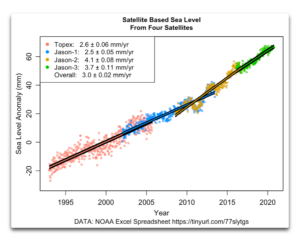by P. Homewood, Feb 27, 2021 in NotaLotofPeopleKnwoThat
One of the most common arguments climate alarmists make is that rate of sea-level rise is “accelerating” or rising faster every year.
Sea-level data reported from satellites indicate seas are rising approximately of 3.3 mm/year (See Figure 1). By contrast, tidal stations have recorded a rise of approximately 1 to 2 mm annually, a rate which is little changed over the century or so for which we have adequate records. Indeed, as reported in Climate at a Glance: Sea Level Rise, the oldest tide gauge in the USA, in New York City, shows no acceleration at all going back to 1850.
Why the large difference?
The answer it turns out is simple. When NASA and NOAA launched new satellites, the data they produced wasn’t the same as the data recorded by earlier satellites.
…

Figure 2. NOAA sea level data, showing the trend of each of the full individual satellite records and the overall trend. SOURCE: NOAA Excel Spreadsheet
Full post here.
